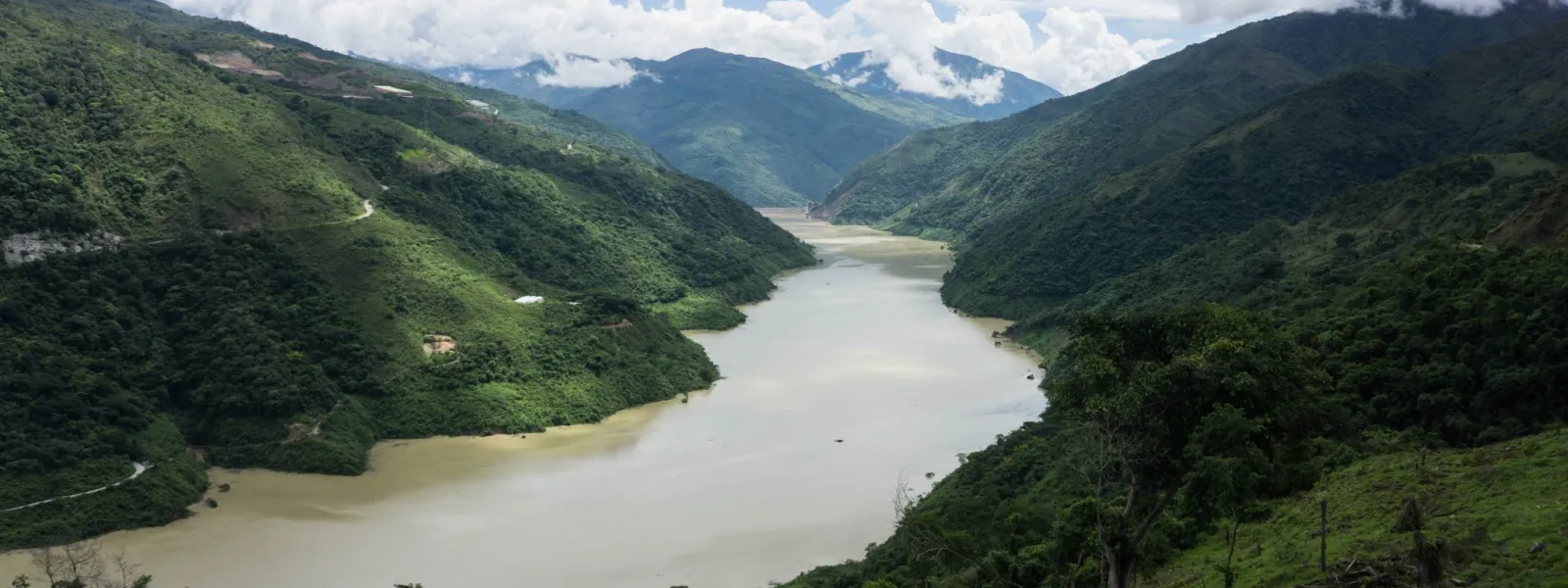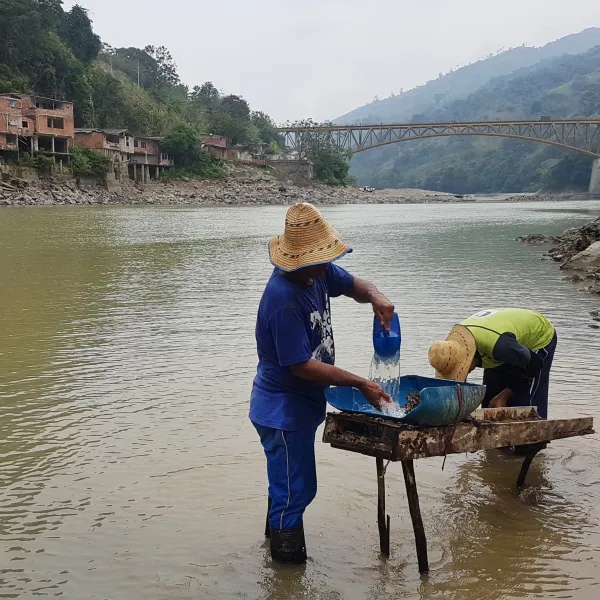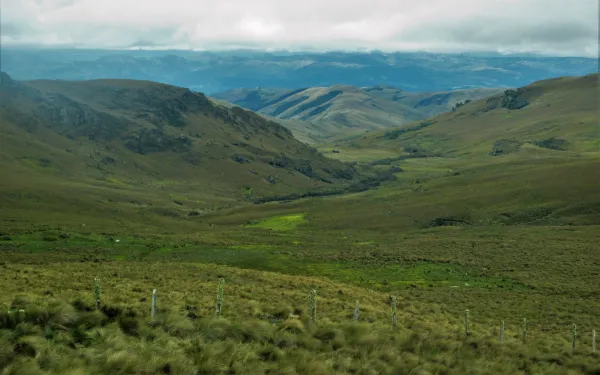
Project
Bram EbusSeeking justice for communities affected by the Hidroituango dam
The Cauca River is the second largest in Colombia. Many of the communities settled throughout its expansive watershed depend on the river for their livelihood, includingd fishing and agriculture.
Winding its way through the Andes mountains, the river courses through seven departments of Colombia, including Antioquia, now home to the Hidroituango Dam—a project that has created an unprecedented humanitarian crisis.
In May of 2018, an error in the dam’s construction caused floods, landslides, avalanches, and the evacuation of more than 25 thousand people. This tragedy exposed the inadequate evaluation of the project’s environmental impacts and the lack of environmental regulation in the dam’s authorization processes.
The project has led to systematic human rights violations, including the disproportionate use of force and an increase in violence against affected communities, who are represented by the Ríos Vivos (“Living Rivers”) Movement of Colombia.
Though construction is not complete, and electricity has not yet been generated, the dam has flooded more than 4,500 hectares of vegetation, releasing a significant amount of methane—a greenhouse gas that aggravates the global climate crisis.
And despite its inadequate implementation, IDB Invest, a private branch of the Inter-American Development Bank, invested millions of dollars into the hydroelectric project and facilitated the investment of billions more from other international banks.
Communities affected by Hidroituango have spent decades denouncing the serious problems caused by the dam, and will not waver in their struggle to defend their land and water.
Partners:

Related projects
Raising people's needs in tackling climate change
Every day we hear a new story about a family affected by extreme changes in climate. Some suffer from severe droughts, others from serious rainfall and flooding, and still others from intense heat waves and forest fires. Local realities must be considered at the international level as governmental institutions decide how to provide finance for climate adaptation and mitigation. AIDA brings the concerns of communities most affected by this global issue to the attention of governments and financial institutions. We have the technical capacity to support governments’ decision making processes on climate change "They can rely on us to provide effective solutions based on our technical knowledge, research, work experience, and relationships with local communities. International decisions about project funding have direct impact on the national and local levels. Bad decisions will result in bad projects," explains Andrea Rodríguez, an AIDA attorney. Our commitment to protecting the interests of the most vulnerable communities has led us to follow closely development of the Green Climate Fund (GCF). This new institution is expected to channel most financial resources for climate change projects and programs in developing countries. We have participated in GCF board meetings around the world and have made local needs heard in consultations with the Secretariat. Last month we attended the annual meeting of the Climate Investment Funds (CIF) in Montego Bay, Jamaica. The CIF are multilateral climate finance funds that provide resources to 48 developing countries. We shared our experience in GCF discussions with participants and civil society observers. "It's important to share experiences of what works and what does not to ensure that civil society replicates successes and corrects failures. Civil society shares the common goal of achieving a paradigm shift in decisions that impact climate," says Rodriguez. In the first session of the CIF Stakeholder Day, Reaching into the Roots of Partnership: Experience from the Ground, panelists discussed lessons learned and next steps on effective stakeholder engagement in the CIF and other global funds. Panelist Andrea Rodriguez, Legal Advisor for the Inter-American Association for Environmental Defense-Americas, reflects on the session.
Read more
Letter presenting Latin American civil society organizations' concerns on the dilution of the World Bank's safeguards policies
Latin American civil society organizations "strongly recommend that CODE members send the first draft back to Management. Without structural changes to the Safeguard Policy proposal, we question if the second phase of consultations and the review process will be meaningful". According to them, dilution of the current Bank Safeguards Policy is evident throughout the draft. Basic World Bank requirements to assess and manage environmental risks and impacts before approval are now relaxed by providing the unbounded deferral of appraisal of significant environmental and social risks or impacts to implementation. A second major concern is that the draft proposed Social and Environmental Policy and ESSs significantly shift responsibility for safeguards implementation to borrowers, but provides less clarity than current exists on when/how the use of borrower systems would be preferable and acceptable. It remains unclear how the proposed draft will help the Bank and Borrowers make decisions to prepare or use borrower systems to effectively implement safeguards in countries where major dilutions of national social and environmental frameworks are being proposed or recently approved. "The proposed draft misses opportunities to meet the highest international standards. The draft provides no binding language regarding international human rights standards and allows governments to "opt out" of compliance to the Indigenous Peoples Policy to protect Indigenous Peoples rights, which unequivocally undermines the international consensus regarding the specific and fundamental rights of indigenous peoples over their lands, resources and the course of their own development", the organizations argue.
Read more
Giving People a Voice on Hydropower Projects
Hydropower projects are on the rise in Latin America as governments seek to feed growing economies. But at what cost? The plants may harness the energy capacity of running water, a renewable resource. But poorly planned and implemented dams, especially large ones, can bring myriad harms to the environment and communities. They affect fish and water quality, and they increase emissions of methane, a gas that contributes to global warming. Flooding displaces people from their homes and communities. This costs them their jobs as farmers, fishermen and hunters – and for ethnic and peasant communities, even their cultures and traditions. AIDA works with individuals and communities to protect them from poorly conceived and developed projects by using the law to defend their right to a healthy environment. This month AIDA and other organizations submitted a brief (in Portuguese) to Brazil’s Supreme Federal Court. The information demonstrates that congressional approval of the Belo Monte Dam in 2005 is illegal because the government didn’t guarantee the affected communities in the Amazon their right to consultation and free, prior and informed consent. Some meetings were held after approval of the project, and then with just scant and incomprehensible information in foreign languages for the communities. There was also little forewarning to attend. It was like telling you that your front yard is to become a street after the diggers have already started removing the lawn. The dam – which is to be the world’s third largest – is under construction and already displacing people without anyone giving them a chance to say no to the project in their own front yard. This is the first time that our combined efforts have reached the Supreme Court for a final decision on Belo Monte, said AIDA attorney María José Veramendi Villa. If the court rules against the legality of the project, then construction will have to stop and the harms righted for failing to consult the communities beforehand. If the opposite happens, the project will continue – and so will we. We will continue to provide assistance to the Brazilian Prosecutor’s Office as it pursues more than a dozen other cases against Belo Monte. These are cases that can also advance to the highest court with the goal of protecting communities from this and other dams in the Amazon. Our efforts to help communities fight dam projects are gaining attention. The Personería of San Carlos (the municipal ombudsperson), a town in northwestern Colombia, contacted AIDA to provide expertise in international environmental and human rights law. They want help in preventing the granting of a license for construction of the El Porvenir II Dam on the Samaná Norte, the last undammed river in the area. AIDA attorney and human rights and the environment fellow, Ana María Mondragón, went there to speak at a public environmental hearing for the project. The good news is that the dam has yet to be approved, meaning that there is still time for the communities to find out what could happen and voice their concerns. The government will have to take the community input into consideration before approving the project, with the possibility that the developer may have to amend construction plans – or abandon them altogether. El Porvenir II will affect fishing, a main source of work and food for the largely poor people in San Carlos. It will also flood an area where many Colombians are seeking to recover the lands that they were forcibly displaced from as result of an internal armed conflict that started more than five decades ago. “We have entered at an early stage, before the project has been approved,” said Mondragón. “We intervened in the hearing to show the inconsistencies in the environmental impact assessment made by the company and the harms that the Porvenir II dam would have in the community. We hope this will help the authorities in their decision-making process to not grant the license.” With your help, we can keep assisting Latin American communities free of charge to exercise their right to say what happens on their land and defend themselves with the law.
Read more